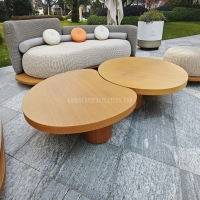Welcome to the website for landscape facilities products and knowledge.
How does the table’s design promote ergonomic comfort for users during prolonged use?
In today's digital workspace environment, where many professionals spend hours working at their desks, the ergonomic design of tables has become crucial for maintaining comfort and health. The fundamental principle behind ergonomic table design lies in its ability to support the natural posture of the human body while minimizing physical strain during extended periods of use.
One of the most significant features contributing to ergonomic comfort is adjustable height mechanisms. Modern ergonomic tables often incorporate electric or manual height adjustment systems that allow users to customize the table's height according to their specific body proportions and preferred working position. This adaptability ensures that users can maintain the recommended 90-degree angle at their elbows and knees, preventing strain on shoulders, neck, and back muscles. The ability to alternate between sitting and standing positions throughout the workday further enhances comfort and promotes better blood circulation.
The table's edge design plays another vital role in ergonomic comfort. Rounded or beveled edges prevent uncomfortable pressure points on the wrists and forearms, which is particularly important for tasks requiring extensive typing or mouse usage. This thoughtful edge treatment eliminates the sharp corners that can dig into the skin during prolonged work sessions, making continuous contact with the table surface more comfortable.
Surface material selection also contributes significantly to user comfort. Tables with slightly textured, warm-touch surfaces provide a more pleasant experience than cold, hard materials. These surfaces reduce glare and minimize the visual fatigue that can occur when staring at screens for extended periods. Additionally, materials with appropriate friction coefficients prevent items from sliding too easily while allowing smooth movement of arms and wrists across the surface.
Proper legroom and knee space design ensure users can sit close to their work surface without constraining leg movement. Adequate depth and width in this area prevent users from adopting awkward postures to accommodate their legs, which could lead to long-term musculoskeletal issues. The stability of the table structure also contributes to comfort by eliminating distracting vibrations or movements during use.
Cable management systems, while not directly related to physical contact, enhance overall ergonomic comfort by reducing clutter and creating a more organized, stress-free workspace. This psychological comfort complements the physical benefits of well-designed tables.
Integration with other ergonomic accessories, such as monitor arms and keyboard trays, further enhances the table's comfort-promoting capabilities. These integrated solutions allow for perfect positioning of all work tools, creating a harmonious system that supports the body's natural alignment throughout the workday.
The cumulative effect of these design elements is a workspace that actively supports user wellbeing rather than merely providing a surface for work. By addressing both the physical and psychological aspects of comfort, ergonomic table design significantly reduces the risk of work-related musculoskeletal disorders, enhances productivity, and improves overall job satisfaction. The investment in properly designed ergonomic furniture ultimately pays dividends in both employee health and organizational performance, making it an essential consideration for any modern workspace.
Related search:

Recommendation
Elliptical metal outdoor table with nested design, resembling wood grain, round table